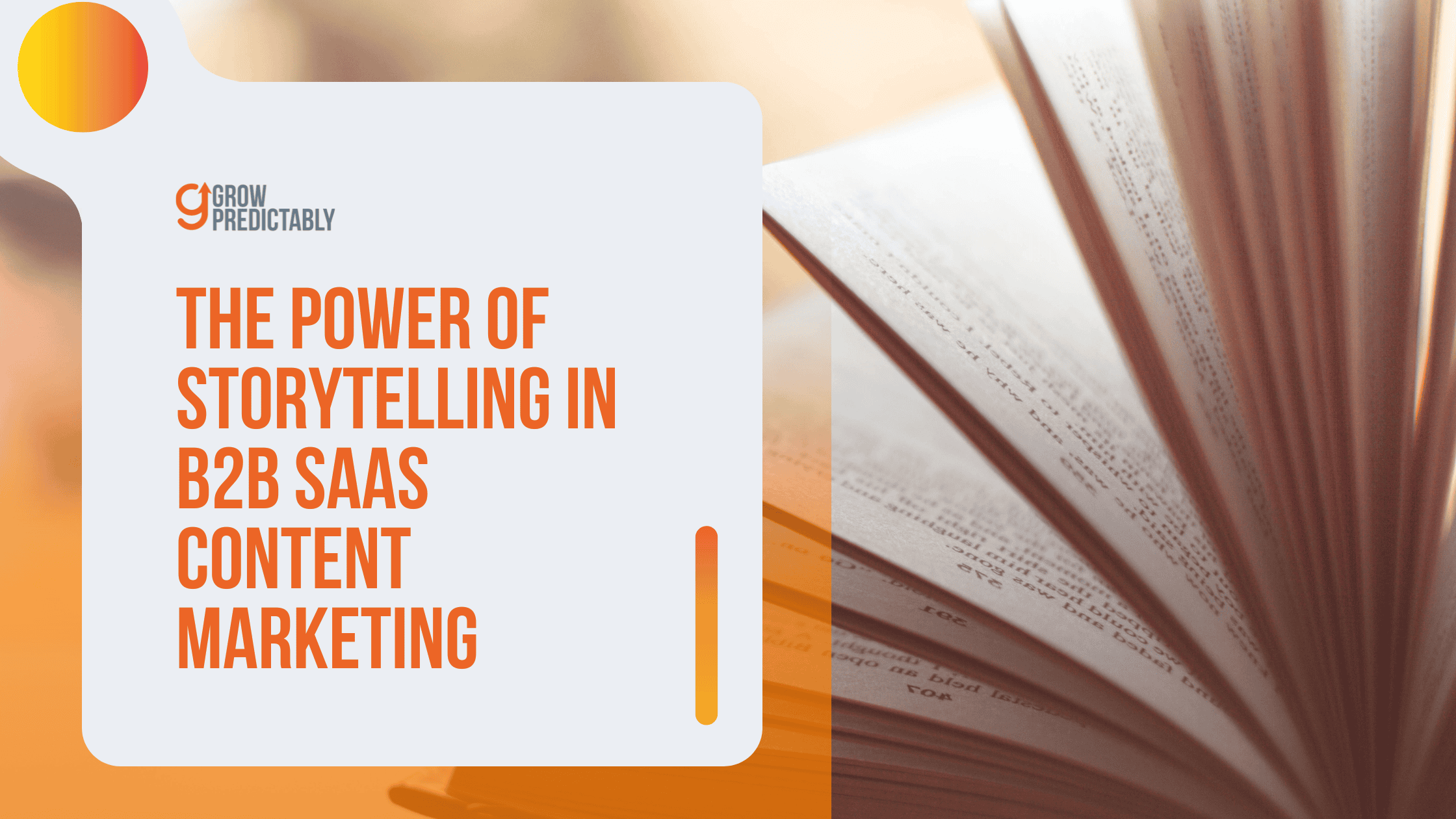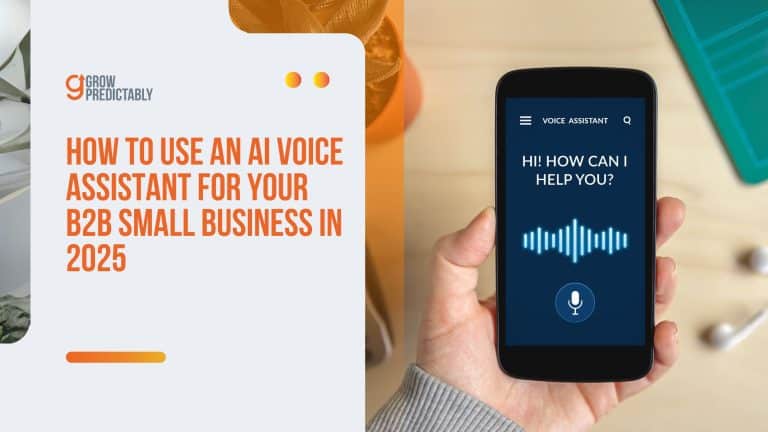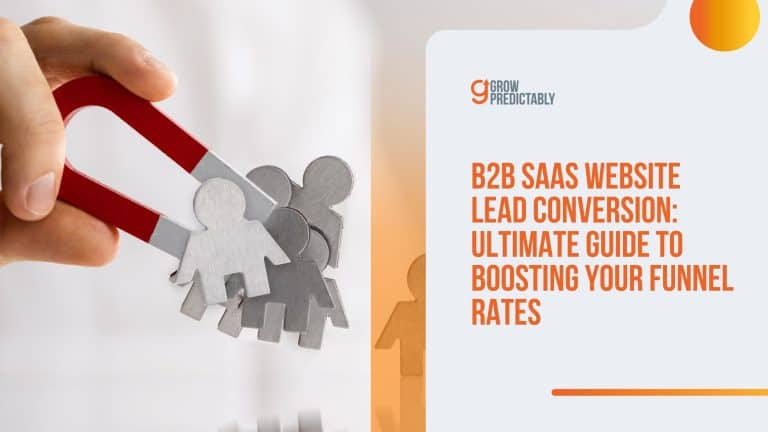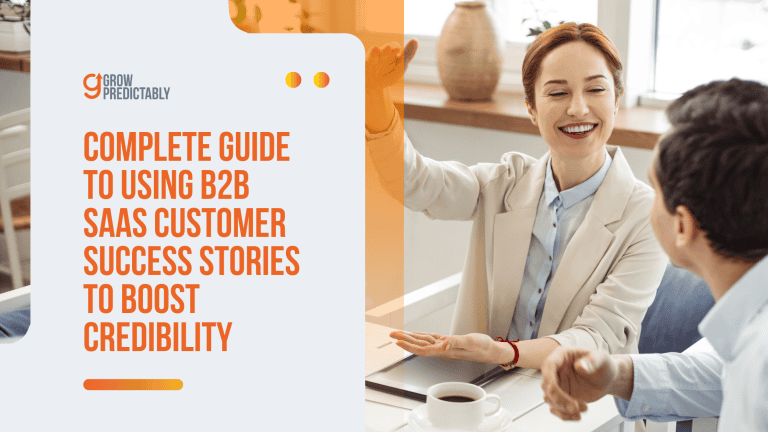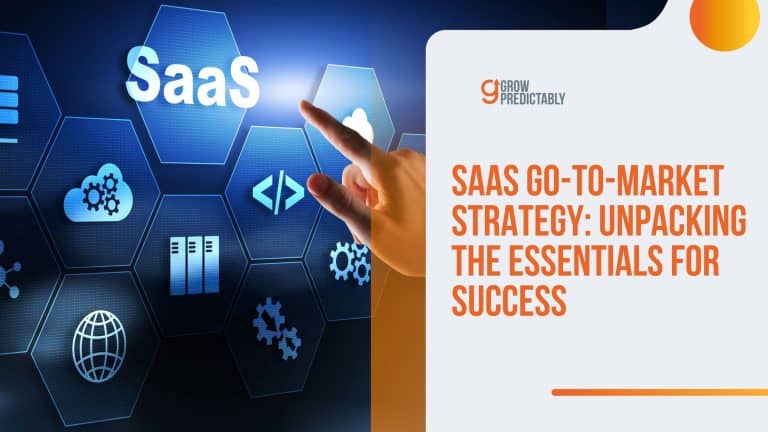The Power of Storytelling in B2B SaaS Content Marketing
Are your B2B SaaS marketing efforts falling flat?
You’re not alone—many businesses struggle to make their technical content engaging.
The common mistake? Thinking that data alone can sell a product. In reality, stories are what capture attention and keep customers coming back.
The problem is that many SaaS marketers believe that storytelling doesn’t fit in a technical or B2B environment.
But that’s not true. By overcoming this misconception, you can use storytelling to create emotional connections that set your brand apart—especially with a framework designed to increase your value.
By implementing storytelling techniques, you can increase engagement, build trust, and ultimately drive conversions.
Keep reading to uncover the secrets of storytelling in B2B SaaS content marketing.
Why You Need Storytelling in B2B SaaS Marketing
Ever feel like some marketing messages are just too pushy?
That’s where “Storytelling in B2B SaaS Content Marketing” comes in.
It’s all about creating narratives that don’t scream, “We’re selling to you!” Instead, they draw you in with a story you can relate to and remember.
This is also where most brand storytelling becomes a turn-off to their target audiences.
The best kind of market messaging is subtle yet powerful.
Imagine sharing a customer’s journey in which they found solutions through your product rather than just listing features.
This approach feels more genuine and less like a sales pitch.
Storytelling makes marketing feel more like a conversation and less like a sales tactic.
It’s like sharing a compelling story with a friend—natural and engaging.
Speaking of natural, stories are also part of our very human nature. As one quote puts it:
We are, as a species, addicted to story. Even when the body goes to sleep, the mind stays up all night, telling itself stories.
Jonathan Gottschall, The Storytelling Animal, Author
So, what makes storytelling so effective in marketing efforts, especially for SaaS?
For starters, stories have a way of connecting with us on a personal level.
They help simplify complex ideas and make them more relatable.
This connection isn’t just a feeling; it’s backed by data.
Storytelling can boost engagement rates significantly and even lead to higher lead generation.
People remember stories better than dry facts, which means your message is more likely to stick.
In the B2B SaaS world, where products can be intricate, storytelling helps break down the tech talk into something everyone can understand and appreciate.
It’s about turning your product’s features into real-world benefits through compelling narratives.
This approach not only informs but also inspires potential customers to take action, leading to a more effective marketing strategy.
The Impact of Storytelling on Buyer Behavior According to Studies
Storytelling isn’t just a means to inject an entertainment factor into marketing messages.
It’s an essential element that boosts the effectiveness and resonance of such marketing messages, and there are studies that help prove this claim.
A recent systematic literature review sheds light on how storytelling molds consumer behavior, unveiling four key areas where storytelling plays a crucial role. (Source)

1. Stimulating Brand Identification
Storytelling resonates with consumers by evoking empathy and fostering brand identification.
Compelling narratives help consumers see themselves as part of a brand’s story, enhancing trust and commitment.
However, overly promotional stories can deter purchase intent.
Effective storytelling engages consumers on a deeper level, transporting them beyond the real world.
2. Creating Emotional Value
The review highlights storytelling’s power to create emotional connections with products, enhancing brand loyalty and trust.
While positive emotions boost engagement, overly sentimental stories can harm credibility.
Marketers must balance sentimentality to ensure authenticity.
3. Supporting Consumer Engagement
Engaging narratives not only entertains but also foster consumer interaction and loyalty.
By emotionally connecting with audiences, storytelling enhances participation and encourages the co-creation of value, increasing consumers’ emotional and financial investment in the brand.
4. Propagating Negative Discourses
Not all storytelling outcomes are positive.
Negative narratives from peers or influencers can greatly affect consumer perceptions and choices, often exaggerating aspects and influencing behavior through social dynamics and peer pressure.
In another study published in the Journal of Service Science and Management, researchers explore how storytelling in advertisements impacts consumer purchase intentions. (Source)

Here’s a summarization of the key insights and findings from this research:
Key Influences of Storytelling in Advertising:
- Word of Mouth (WOM): The study reveals that storytelling ads significantly boost consumer purchase intentions through WOM. It acts as a pivotal promotional tool, where 20% of WOM discussions are related to advertising, leading to brand recommendations.
- Entertainment Factor: Ads that incorporate entertainment elements increase consumer engagement and positively affect purchase intentions. The research highlights that entertainment not only captivates but also aids in brand recall.
- Memorability: Memorable ads leave a lasting impression, influencing purchasing decisions. The study found that memorable storytelling ads have a significant impact on consumer intentions, supporting the hypothesis that memories play a crucial role in decision-making.
- Time Duration: The study underscores the importance of the duration of ads. An optimal time span enhances engagement and recall, significantly impacting purchase intentions.
In conclusion, storytelling is a powerful marketing tool that significantly influences buyer behavior by fostering brand identification, emotional connections, and consumer engagement.
Its ability to enhance word-of-mouth promotion, entertainment, memorability, and optimal ad duration underscores its impact on purchase intentions.
In the context of B2B SaaS content, storytelling helps humanize complex solutions, build trust, and spark meaningful relationships, making it indispensable for engaging prospects and driving conversions in a competitive digital marketplace.
The Challenges of Storytelling in B2B SaaS
Storytelling in B2B SaaS is no walk in the park.
Marketers often juggle between technical content and engaging narratives.
Here are five challenges they face and how to tackle them:
- Managing Complex Sales Cycles: B2B sales cycles can be long and intricate. This complexity makes it hard to keep the story simple and engaging. To overcome this, break down the process into smaller, digestible parts. Share relatable customer stories that highlight each stage of the journey.
- Integrating Product-Led Growth Stories: In a world where features matter, incorporating them naturally to make a compelling narrative is tough. The key is to show, not tell. Use real-life customer success stories where your product played the hero. This makes the technical stuff feel more human and relatable.
- Ensuring Brand Consistency: With many voices contributing to content, keeping a unified brand story can get tricky. Develop clear brand guidelines for your brand storytelling that everyone can follow. Regular team meetings can also help align the narrative, ensuring every story speaks the same language.
- Addressing Diverse Audience Needs: B2B audiences vary widely, from tech-savvy engineers to business-minded executives. Tailor your storytelling to speak to each group without losing the overall plot. Create different versions of the same story, focusing on what matters most to each audience segment.
- Maintaining Authenticity: Authenticity can sometimes get lost in technical jargon. Maintain authenticity by employing clear and direct language. and focusing on genuine customer experiences. Readers can spot fluff from a mile away, so always stick to the facts and honest narratives.
By tackling these challenges head-on, marketers can create stories that not only inform but also engage and inspire action in the B2B SaaS world.
How to Build a Compelling B2B SaaS Story Framework

Framing a dynamic and compelling story from scratch can be daunting, especially in the B2B SaaS world.
That’s why having a solid framework is a game-changer.
In this section, we’ll breakdown a four-part framework that’s going to serve as the foundation of how you’re B2B SaaS narrative is going to unfold through your marketing messages.
This four-part framework includes:
- The Hero
- The Destination
- The Antagonist
- The Mentor
This framework gives you and content marketers a foundation to craft engaging customer centric narratives without reinventing the wheel every time.
Let’s break down the B2B SaaS story framework into four key elements:
Hero
In every compelling story, there’s a hero. Here, it’s your customer or the B2B SaaS client. They’re on a mission to solve a problem and achieve their goals. This element humanizes your narrative, making it relatable and focused on the customer’s journey.
Destination
This is the goal the hero wants to reach. It could be increasing efficiency, cutting costs, or scaling their operations. Clearly defining the destination helps your target audience visualize success and understand what they can achieve with your help.
Antagonist
Every hero faces challenges. In this framework, the antagonist is the problem that’s blocking the path to success. It could be outdated processes, limited resources, or complex industry hurdles. Identifying these obstacles makes the story realistic and sets the stage for your solution.
Mentor
Enter your SaaS solution. As the mentor, your product guides the hero toward their destination. This part of the story showcases how your SaaS offering empowers customers to overcome their challenges and achieve their goals. It’s about positioning your solution as a trusted ally in their journey.
Using this framework not only simplifies storytelling but also makes it impactful.
It allows potential customers to see themselves in the narrative, understand their challenges, and recognize your SaaS product as the key to their success.
By doing so, you’re more likely to engage your target market, build trust, and inspire action.
Get started with this framework by trying out the tool below.
You may just come up with a draft for your next social media post.
Turn Testimonials Into Social Media Stories
Effortlessly transform customer feedback into engaging narratives for your next social post.
Storytelling Strategies to Utilize in Your B2B SaaS Marketing Messages

Even if you don’t have a background in writing, these strategies will help jumpstart your ability to create compelling stories that connect with your B2B audience through proven but simple tactics.
By using these storytelling frameworks commonly used in real world examples, you can confidently craft marketing messages that connect with your prospects and customers, no matter their stage in the buyer’s journey.
1. P-A-S (Problem-Agitate-Solution)
This classic formula begins by identifying a problem your target audience is facing, followed by agitating that problem to make it feel urgent, and finally presenting your solution.
It’s powerful because it grabs attention and builds emotional tension, which keeps the reader engaged until the problem is solved by your product.
It’s straightforward and highly effective for B2B SaaS marketing, where problems and solutions are at the heart of purchasing decisions.
Example:
Jane’s team was constantly bogged down with manual data entry, causing delays and mistakes that hurt their productivity. As the problem grew, the team found themselves losing hours each week just trying to keep up with tasks that could have been automated. That’s when Jane discovered ABC, the all-in-one automation software that eliminated manual tasks, letting her team focus on what really matters.
Utilizing writing formulas like PAS and AIDA has transformed my approach to crafting compelling narratives in blog intros, making them more engaging and structured.
Intros are crucial in capturing reader interest, and these frameworks offer a reliable blueprint for starting strong.
By focusing on the Problem-Agitate-Solution (PAS) and Attention-Interest-Desire-Action (AIDA) frameworks, I can create compelling openings that draw readers in and set the stage for the rest of my content, ensuring they remain hooked from the start.
2. Before-After-Bridge (B-A-B)
The Before-After-Bridge framework takes the audience on a journey.
First, you paint a picture of what life is like before using the solution.
Then, you describe how great life could be after the solution.
Finally, you build a bridge between the two, showing how your product can help them move from their current challenges to their desired future.
Example:
Before using ABC, Joe’s team was buried under a mountain of support tickets, with no clear way to streamline the process. After implementing ABC, they reduced ticket response times by 40%, and customer satisfaction soared. The bridge was simple—ABC’s automation tools brought clarity and efficiency to Joe’s customer support, freeing up time and boosting productivity.
3. Promise–Picture–Proof–Push (PPPP)
This framework starts with a promise to solve a problem or improve a situation.
Next, it paints a picture of what life will be like after this problem is solved, followed by providing proof to back up your claims.
Finally, it pushes the audience to take the next step.
It’s a more structured storytelling approach that builds confidence with concrete evidence.
Example:
ABC promises to cut your project management time in half. Imagine a world where every task is clearly assigned, deadlines are met, and nothing slips through the cracks. In fact, after using ABC, over 200 companies reported a 50% increase in project completion rates. Don’t let another day go by in chaos—try ABC today and see the results for yourself.
4. Attention-Interest-Desire-Action (AIDA)
The AIDA framework is a staple in marketing.
It begins by grabbing attention, sparking interest by explaining why the product is relevant, creating desire by illustrating the benefits and finishing with a clear call to action.
It’s ideal for leading potential customers through a step-by-step decision-making process.
Example:
Struggling to keep track of all your team’s projects? ABC grabs your attention by offering a single dashboard that keeps everything organized. You’ll see every task, deadline, and team member at a glance—imagine the productivity boost that comes with such clarity! With ABC, project management becomes smooth and effortless. Ready to simplify your workflow? Try ABC today and see the difference.
By using these storytelling strategies, even if writing isn’t your strength, you’ll be able to craft B2B SaaS marketing messages that are clear, engaging, and persuasive.
So whether you’re highlighting customer problems or offering solutions, these frameworks will help you tell compelling stories that connect with your target audience.
B2B SaaS Storytelling + CVJ = Supercharged Content Marketing
Storytelling is a great marketing tool that helps create messages that connect with people.
When incorporated with the Customer Value Journey (CVJ), storytelling does more than just entertain—it helps turn potential customers into loyal fans of your product.
The CVJ is a digital marketing framework that helps businesses design a buyer’s journey that effectively fosters loyal customers by taking them through an eight-stage, value-driven journey from awareness to raving fans.
Leveraging storytelling practices in each of the different stages of this marketing framework helps brands like yours optimize their marketing messages for increased resonance.

Here’s how you can weave storytelling into each stage of the CVJ:
1. Awareness Stage
Storytelling Goal: Introduce your brand and create awareness through engaging and relatable stories.
Recommendation: Craft stories that highlight common challenges faced by your target audience and how they can be solved.
Example: Share a story of a typical company struggling with inefficiencies, leading to an introduction of your SaaS solution as a potential help. Use a blog post or videos to present this compelling narrative in your social media strategy.
2. Engagement Stage
Storytelling Goal: Deepen the emotional connection and keep the audience interested.
Recommendation: Use stories that detail how others have engaged with your product, showcasing real results and interactions.
Example: Feature a case study or customer testimonial video where a client describes their journey using your product, focusing on their initial skepticism and eventual satisfaction.
3. Subscribe Stage
Storytelling Goal: Encourage potential customers to take a small step, like signing up for a newsletter.
Recommendation: Narrate a story that offers a glimpse into exclusive content or benefits they’ll gain by subscribing.
Example: Create an email series teaser that promises insights similar to those gained by past subscribers who solved significant problems using your insights.
4. Convert Stage
Storytelling Goal: Turn subscribers into paying customers.
Recommendation: Use stories that highlight successful conversions and emphasize the ease and impact of taking that step.
Example: Share customer success stories of subscribers who turned into clients and saw measurable improvements, using data points to highlight the benefits.
5. Excite Stage
Storytelling Goal: Enhance the customer experience and satisfaction.
Recommendation: Tell stories that illustrate the excitement and satisfaction of existing customers post-purchase.
Example: Develop a welcome video or interactive content for new customers that shares stories of immediate wins they can achieve with your SaaS.
6. Ascend Stage
Storytelling Goal: Encourage customers to explore more advanced offerings.
Recommendation: Narrate stories of customers who ascended to premium features and reaped greater rewards.
Example: Use a detailed blog or video series to showcase the journey of a customer who upgraded and experienced significant business growth.
7. Advocate Stage
Storytelling Goal: Inspire satisfied customers to promote your product.
Recommendation: Share stories of advocates who have benefited from promoting your product.
Example: Highlight a customer who referred others and received benefits, perhaps through a loyalty program or public acknowledgment.
8. Promote Stage
Storytelling Goal: Encourage customers to actively promote your brand.
Recommendation: Share compelling stories that show the impact and rewards of being a brand ambassador.
Example: Develop a campaign with stories of top promoters, their rewards, and how they’ve helped the company grow, encouraging others to participate.
When you add storytelling to each part of the Customer Value Journey (CVJ), you make your marketing messages more fun and interesting.
It also helps guide your customers through a clear path that builds loyalty and support.
This way, your content strategy sticks with them and helps you reach your business goals.
Tips to Balance Emotional Appeal and Technical Information in SaaS Storytelling

Storytelling frameworks can make your SaaS messaging more engaging and human-centered.
However, balancing the emotional appeal with the necessary technical details is key to ensuring your narrative resonates with both decision-makers and users.
Below, we’ll outline five essential tips that will help you strike this balance and craft SaaS marketing messages that are not only compelling but also informative.
1. Use Technical Information as Proof for Your Claims
When making emotional appeals, back them up with solid technical information to build trust and credibility.
Share relevant data, specifications, or performance metrics that demonstrate how your SaaS solution solves your target user’s problems or pain points.
This approach ensures your emotional messaging isn’t just fluff—it’s supported by facts and results.
For instance, after highlighting the pain points, use features or metrics to prove your product’s effectiveness that help address these pain points.
2. Simplify Complex Concepts Without Losing Substance
Technical jargon can be a turnoff if overused, but simplifying everything risks watering down your message.
The key is to break down complex ideas into easy-to-understand language while still retaining the essence of the technology.
Use analogies or relatable metaphors to convey technical aspects without losing the attention of non-technical decision-makers.
This keeps your message accessible without undermining the sophistication of your solution.
3. Leverage Customer Testimonials and Case Studies
A good way to bridge the gap between emotional appeal and technical depth is through customer success stories.
These real-world examples of customer success stories naturally blend emotion—through customer challenges and successes—with the technical details of how your product was used to overcome those challenges.
Not only do testimonials/case studies/customer success stories make your content relatable, but they also provide social proof of your technical claims.
4. Focus on Benefits Over Features, Then Dive Deeper
Start with the emotional appeal of the benefits your SaaS product provides, such as saving time or reducing frustration.
Once you’ve established the value, dig deeper into the technical features that enable those benefits.
This allows you to captivate your audience emotionally while also satisfying their need for concrete details.
The benefits hook them in, and the features reinforce why your product delivers on those promises.
In marketing, when showcasing a product to potential users, you must focus more on its benefits rather than just its features.
By emphasizing how the product can enhance various aspects of their lives or solve problems, users can better grasp the product’s value.
This approach engages them on a personal level, making the product relatable and desirable to their senses.
Instead of reciting features, highlighting benefits paints a vivid picture of the product’s impact, leading to a stronger emotional connection with the audience.
5. Align Technical Information with the Customer’s Journey
The amount of technical detail you include should be aligned with where your prospect is in the customer’s journey.
In the early stages, emotional appeals and high-level benefits are more effective, while detailed technical information becomes crucial later, as prospects are evaluating solutions.
Make sure your storytelling evolves as the buyer progresses, with more technical details introduced as they get closer to making a decision.
Measuring the ROI of Storytelling in SaaS Content Marketing
Tracking the return on investment (ROI) of leveraging storytelling in your SaaS content marketing strategy can be challenging, but it’s crucial for understanding your efforts’ effectiveness.
By measuring key performance indicators (KPIs), you can assess and optimize your storytelling for better results.
Here’s how B2B SaaS content marketers can track their storytelling success by focusing on six key KPIs.
1. Organic Traffic
Storytelling, when done well, can significantly improve organic traffic by creating content that ranks higher on search engines and resonates with your audience. To measure this:
- Track Your Traffic: Use tools like Google Analytics to monitor how many visitors land on your website through organic search.
- Check Keyword Rankings: Make sure the stories you’re telling are targeting the right keywords that your audience is searching for.
- Compare Before and After: Assess changes in organic traffic before and after implementing storytelling into your content strategy. A positive trend suggests your stories are engaging your audience and ranking well.
2. Conversion Rates
The emotional appeal of storytelling can drive readers to take meaningful actions—like signing up for a free trial or booking a demo. Measuring conversion rates is crucial in understanding how storytelling influences your audience’s behavior. Here’s what to do:
- Set Up Goal Tracking: Use tools like Google Analytics or your CRM to track conversions linked to specific storytelling pieces.
- Segment by Story: Identify which stories are driving the highest conversion rates, and replicate those successful elements.
- Analyze Call-to-Actions (CTAs): Ensure that your stories contain clear and compelling CTAs that guide readers toward the next step in their journey.
3. Bounce Rate
If readers are bouncing off your site after visiting just one page, it may indicate that your stories aren’t compelling enough to keep them engaged. Here’s how to keep tabs on this metric:
- Monitor Bounce Rate: Use Google Analytics to track the bounce rate of specific pages that feature your storytelling.
- Identify High Bounce Rates: If certain stories have a high bounce rate, revisit them to improve the hook, structure, or content relevance.
- Improve Storytelling for Engagement: Incorporate more emotional appeal or clearer problem-solution narratives to reduce the bounce rate and keep visitors interested.
4. Average Time on Page
The amount of time readers spend on your storytelling pages can give you insight into how engaging and compelling your content is. Here’s how to measure it:
- Track Average Time on Page: Use tools like Google Analytics to measure how long visitors stay on pages featuring your stories.
- Look for High Time on Page: A high average time indicates that visitors are spending more time reading your stories, which suggests strong engagement.
- Optimize for Length and Depth: If time on the page is low, consider revising your stories to make them more engaging or expanding on certain areas to hold the reader’s attention longer.
5. Retentiothe Rates
Storytelling can play a major role in keeping your customers engaged and coming back for more, which ultimately boosts retention rates. Here’s how you can measure it:
- Track Customer Retention: Use your CRM or analytics tools to track how many customers stay loyal to your brand over time after consuming storytelling-driven content.
- Measure Engagement Over Time: See if your retention rates improve after deploying storytelling, particularly in newsletters or email marketing campaigns.
- Identify Patterns in Successful Stories: Note which stories lead to higher retention rates and replicate their elements in future content to maintain customer engagement.
Key Takeaways
Storytelling in B2B SaaS content marketing strategy is a powerful tool that can transform dry, technical content into engaging narratives that resonate with your audience.
By weaving emotional appeal into your marketing messages and balancing it with the right amount of technical detail, you can build stronger connections, increase engagement, and drive conversions.
From using frameworks like P-A-S and AIDA to following the Customer Value Journey, storytelling helps simplify complex ideas and makes your SaaS solution more relatable.
Now is the time to put these strategies into practice.
Start crafting compelling narratives that speak to your customers’ challenges, showcase your solution as the hero, and guide them through every stage of their journey.
Ready to level up your marketing strategy? Check out our other blogs on digital marketing, business, and mindset for more actionable insights and tips to grow your business effectively!

